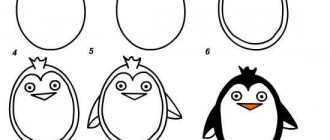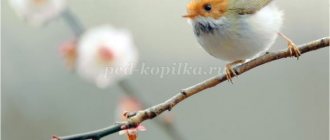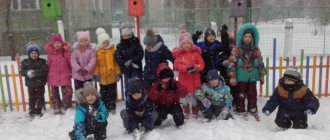Progress of observation
As if across the sky from the north, it threw down, poured
A white swan swam to the fields of the lake,
The well-fed swan swam. White fluff and feathers.
Look at the sky, what do you see? What are the clouds like today? Do you think it will rain or snow today?
In what direction are the clouds moving? What are the clouds like today? How can you tell the weather by looking at the clouds? On a cloudy day, ask the children what they see in the sky. Notice that the clouds are moving, sometimes they move slowly, sometimes quickly. What are they? If there are clouds in the sky, they cover the sun, then it’s not so hot outside. With children, remember that clouds can be cirrus and cumulus. Determine what clouds are in the sky on the day of the walk.
Labor activity Cleaning the site from winter debris - Goal: to develop work skills and a sense of teamwork.
Outdoor games “River figure”
,
“Change the word”
(replace the subsequent part of the word ice drift so that you get something else - ice cutter, icebreaker, ice carrier, etc.).
Goal: to develop attention and logical thinking.
"Hunters and Hares"
— teach children to take the correct stance and swing
Individual work
Development of movements - learn to jump without touching or moving the sticks;
Cognitive and research activities
Parachute"Goal: consolidate knowledge about the properties of air (elasticity, understand how air force (movement)
.
Work before bed
Reading
Self-service and email everyday life work Reading "Woodpecker"
K. D. Ushinsky N. Goal: to cultivate an emotional and figurative perception of works, to teach to understand figurative expressions, to lead to an understanding of the genre features of the poem.
Work assignments. Purpose: to teach children to complete the work they have begun, to discuss the saying “If you’ve done the job, walk boldly”
.
Evening: Engine.
Communicative
Labor Gradual rise of children, air baths, invigorating gymnastics, walking along the path of health.
Staging of a fairy tale Small forms of folklore: “We lived with my grandmother...”
simulation games that reflect the physical characteristics of movements, voices, and the emotional state of the game image “big and small birds ”
IMP "Who left?"
Goal: develop attention Develop fine motor skills "Laying out
bird "
Exercise "Who does what"
.
Goal: to contribute to the expansion of the verb vocabulary. Independent work in the physical education corner. Goal: organize independent motor activity, improve motor skills. Develop independence, creativity, encourage activity. Contribute: D. I. “What kind of bird ”
Goal: To develop the ability to independently find
birds and distribute them into groups ; hats for dramatizing the fairy tale “We Lived at Grandma’s...”
Program content Equipment and materials
FR 3. FISO No. 53 Penzulaeva L. I. Page. 81.
Repeat the walk with a change in pace; practice crawling on a gymnastic bench; in balance and jumping. Cubes for outdoor switchgear, balls (diameter 20-25 cm)
for
half a group , 2 gymnastic benches, bags (8 - 10 pcs., hoops 3-4.
Walk D.I.P.I., play Observation of the wind. Give knowledge that birds rarely fly . Why do you think ?
P.I. “Swallow”
Complication: running with an object in hand. Purpose: To strengthen children’s ability to run easily and rhythmically, to coordinate the movements of their arms and legs when running. Develop dexterity, coordination of movements, cultivate goodwill, improve children's health
P.I. “Replace the item”
Goal: To help children improve their performance of basic movements when running at speed. Develop reaction speed, develop the ability to focus on the actions of comrades.
Wednesday Morning:
SPF
receiving children, games, communication, morning exercises, duty, preparing for breakfast, breakfast, activities. after breakfast, preparation for OOD. Engine
Communicative
Labor Morning exercises.
Conversation “ Birds in spring ”
.
Goal: To enrich children's knowledge about birds that fly from warm regions in the spring , their names, spring chores, and their meaning in nature. Show the dependence of the return of birds on the awakening of nature. To consolidate children's ideas about the structure of a bird , to encourage them to recognize a bird by its characteristic silhouette features: beak, paws, neck, tail, wings. Cultivate interest, careful, caring.
Making riddles about different birds . Invite the children to draw answers.
Goal: to develop the ability to recognize birds by their characteristic features and display them in your drawings. D.I. “Recognize the bird by description ”
Goal: To consolidate the ability to recognize a bird by its characteristic features.
D.I. Bird ’s nest ”
.
Goal: To consolidate the ability to draw with colored pencils with different pressure on the pencil. Conversations, play situations for children's safety to form children's ideas about safe behavior on the street during icy conditions.
Add coloring pages on the topic “ Migratory Birds ”
.Goal: Improve skills in working with pencils.
Enter attributes (elements of clothing, equipment (rod, modules of S.R.I. "Staff Police"
.Goal: To encourage children to independently organize their own play, distribute roles, use attributes and substitute objects.
Folder – moving “Developing the mind and ingenuity”
Invite parents to participate in collecting information for the encyclopedia: “ Birds of our region ”
.
Joint activity on the site with parents and children “Hanging birdhouses
.
NOD KHER Program content Equipment and materials
1. MUZO (according to the plan of the musical director)
PR Mov. 2. FEMP (PR)
No. 27 I. A. Pomoraeva, V. A. Pozina
“FEMP” Senior group Page .
53-55 Introduce the writing of the number 10.
Continue learning to divide a circle into two equal parts, name the parts and compare the whole and the part. Continue to teach how to compare two objects in width using a conditional measure equal to one of the objects being compared.
Strengthen the ability to consistently name the days of the week . Demonstration material. Truck, 10 bars, 2–3 strips (conventional measures, a circle of colored paper, a toy kitten, flannelgraph, 2 cards with the number 1, cards with numbers from 0 to 9, a set of toys (10 pcs.)
.
Handout. A circle of colored paper, scissors, 2 sets of number cards with images of 1 to 7 circles, cards with numbers from 0 to 9, a card with the number 1 (2 pieces for each child, counting sticks.
Walk
D.I.P.I., play Observation of snow The goal is to teach how to observe seasonal changes in nature; consolidate knowledge about the relationships occurring in inanimate nature (sun - snow)
.
Planning
One of the tasks facing a teacher who plans to prepare a chosen topic is to enrich the vocabulary of the children being taught and to actively use the vocabulary of the lesson. In this regard, in daily conversations it is important to use terms, concepts and discuss issues that are directly related to the topic:
Birdhouse
- “migratory birds”, “wintering”, “waterfowl”, “flying for the winter”, “birdhouse”, “nest”, “hatching eggs”, “breeding offspring”;
- swans, ducks, rooks, swallows, storks, starlings, larks;
- where birds live, how they breed, what the growing chicks eat;
- winter is a difficult period in the life of birds; How can people support birds?
The culmination of the work done should be a memorable event, during which the children will be able to take advantage of the acquired knowledge. As a final touch, a thematic quiz, exhibition of crafts or drawings on a given topic is suitable. Parents' participation in the creative process always enhances children's understanding of the significance of the event. What will be truly memorable will be the hanging of feeders on the site, created with the help of the mothers and fathers of the pupils.

Drawing
Mini-project of thematic work
To develop and maintain interest in the proposed topic during the thematic week, it is desirable to create in children additional emotions and experiences that can turn abstract-sounding concepts into more realistic ones.
Interesting! Listening and discussing literary works, dramatization and watching videos and animated materials dedicated to the life of a flock of birds will help the child become more imbued with the desire to help birds and love wildlife.
Progress of observation
At ugly winter crossroads
The snow from the day before yesterday was still there,
He did not like the warm spring bliss,
But it was so difficult to protect yourself!
There are signs: if the snow flakes become large, wait for a thaw; the bullfinch sings in winter in the snow, blizzard and slush - wait for early spring . What happens to snow when the sun gets hot? What color does the snow become? Where does snow melt faster - in the shade or in the sun?
Research activities. Measure the depth of snow in the sun and in the shade.
Labor activity: Sweep snow from buildings and benches. Goal: to teach how to finish what you have started.
Outdoor games "Wolf in the Moat"
,
“Burners”
- Purpose: to teach
to jump over the ditch and back , to quickly run forward ;
"Wolf and Goat"
— Goal: to improve the execution of movements when running and walking.
Individual work “In a straight line”
— Goal: learn to ride a bicycle.
Cognitive and research activities
"Water Evaporation"
Goal: to establish the dependence of water evaporation on air temperature, illumination and water surface area
Work before bed
Reading.
Self-service and email everyday life work Reading L. Tolstoy “Varya had a siskin...”
Goal: To teach emotional perception of the figurative content of the work, understanding the meaning of the author’s use of means of expression.
Exercise “What everyone should have”
.Goal: to remind children about personal hygiene items: toothbrush, comb, handkerchief.
Evening: Engine.
Communicative
Labor Gradual rise of children, air baths, invigorating gymnastics, walking along the path of health.
Conversations with children “How to help birds in spring ”
- repetition of
bird , familiarization with the simplest classification;
nurturing a caring, reverent attitude towards feathered representatives of the animal world. Cognitive and research activity “What do birds build nests ?”
Goal: to identify some features of the lifestyle
of birds in the spring . Speech games and exercises “Compare and name according to the model”
Purpose: education of the comparative degree of adjectives.
Learning the poem “Ten birds - a flock”
I. Tokmakova. Goal: to promote memory development, enrich children’s vocabulary with
bird . FINE Bird's
Nest ” . Purpose: To consolidate the ability to draw with colored pencils with different pressure on the pencil.
Conversation “Good Doctor Aibolit”
.Goal: to develop healthy lifestyle skills.Introduce: attributes for S.R.I.
“Bird Family”
Goal: expand the understanding of birds , develop the ability to establish cause-and-effect relationships, develop communication skills through communication in a team;
Materials for constructive and model activities from paper “Birdhouse”
.Goal: learn to lay out geometric shapes according to
verbal instructions .
Walk D. and P. I, play Outdoor game. "Sparrows and the car"
Goal: to practice running, to teach how to run without colliding with each other, to develop the ability to act on a signal.
Didactic game “Who will fly after whom”
Goal: consolidate ideas about
migratory birds , activate vocabulary.
Thursday Morning:
SPF
receiving children, games, communication, morning exercises, duty, preparing for breakfast, breakfast, activities. after breakfast, preparation for OOD. Engine
Communicative
Labor Morning exercises.
Conversation Getting to know the “ Bird ”
Purpose: to clarify children’s understanding of the structure of birds . Improve the ability to use the symbolic structure of birds
D.I. “Call me kindly.” Birds "
Goal: learn to select words in diminutive form.
Meeting natural history writers
Goal: broadening the horizons of children; nurturing interest in fiction.
Reading A. I. Kuprin “Song of the Starling”
.Goal: learn to answer questions based on the content of the text.
D.I. “Description of
birds . Compiling a story from pictures .
Goal: learn to describe birds , noting their characteristic features. Learn
make up a story using pictures. Learn to solve riddles on the topic.
Educational interactive game “Right - Left”
.Goal: to strengthen the ability to navigate in space.
Didactic game “What is too much?”
Goal: mastering the formation of nouns in the genitive plural.
Drawing on sand “ Bird ”
.Goal: develop motor skills. Introduce: Lotto
“Healthy Products”
. Goal: remember the rules of the game.
attributes for S.R.I. “Let’s feed
the birds ” Goal: expand the understanding of birds
, about their diet, develop the ability to establish causally
-consequences, develop interest in
joint games.
Add portraits of writers.
Organize a book exhibition
Goal: developing interest in the book as a future source of information.
Introducing a diagram for composing a descriptive story about a bird . Purpose: to train children in composing stories about birds .
GCD
Com Software content Equipment and materials
1. Speech therapy by subgroups (according to the speech therapist’s plan )
HER 2. Application (HER)
No. 12.
“Fairytale
Bird ” by T. S. Komarova Page. 87
Strengthen children's ability to cut out parts of an object of different shapes and make an image from them. Learn to convey the image of a fairytale bird , decorate individual parts and details of the image. Strengthen the ability to cut out symmetrical parts from paper folded in half (tails of different configurations)
.
Develop imagination, activity, creativity, the ability to highlight beautiful works and talk about them. Pale background paper, sets of different colored papers, including gold and silver, envelopes with scraps, scissors, glue, glue brush, napkin (for each child)
.
Walk
D.I.P.I, game Observation of the altitude of the Sun The goal is to consolidate knowledge about the influence of solar energy on the life of plants, animals and humans.




